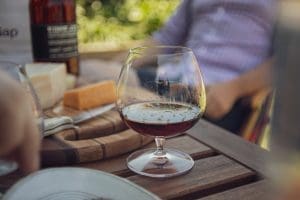
First of all, I’ve always found it a little preposterous that there could be hard and fast rules for drinking any beverage, even one taken as seriously as wine or whisky. The name of this website would suggest a higher level of pretense to this subject; would a Gentleman sip Chateau Petrus over ice through a straw? I have a bit of a libertarian whisper in my ear saying,” if you can afford it, do whatever you want with it.” The point of these Taste Wine guides has always been to provide a framework for the beginner who hopes to reach a higher appreciation of his investment by doing things “the right way.” Or maybe, for a seasoned professional, it represents a return to a sort of wine-based scientific method.
Exploring the existing guides that abound in the beverage media has always left me with a sense that tasting wine “the right way” belies the actual experience most of us have when drinking any sort of fine ferment. We want to get as much enjoyment as possible for the often high prices we pay for these drinks. Cataloguing the fruit flavour components of a wine can’t possible be the best way to do this. This is primarily because even if you are a trained professional taster, differentiating between raspberry and blackberry flavour compounds is both somewhat subjective and largely pointless.
The Wine & Spirit Education Trust(WSET) systematic approach to tasting wine is a widely accepted standard that is rich in wine-trade jargon, and admittedly a method I do try to use occasionally in my own tasting notes. It is fairly useful for cataloguing large numbers of notes in a purely technical manner, and can be used to compare notes to other tasters who use the method. A tasting note from using this method is probably the least successful way to intuitively enjoy a wine, but I like to be familiar with standards like this before I come up with a variation that better fits my needs on a more casual basis. You can see in the chart below that this method is indeed quite technical, the type of terminology is what typically would bring about accusations of snobbery.
While the WSET method undoubtedly provides a lot of observed characteristics of a wine, it quite blatantly leaves little room for whether or not you actually enjoyed it. A lot of the reason for this goes back to the axiom of “there’s only good bottles, not good wines.” The same wine tasted many times over a period of a decade, for example, with different foods and company, inevitably will leave a variety of impressions. This is why I feel that the most important part of any wine tasting is to take note of the context. This means that rather than associating the wine I drink with its technical components, I first and foremost attach some sort of memory to that bottle. We all tend to do this naturally with music and food anyways. The actual tasting methods I’m going to suggest follow suite from this context-first methodology.
The first observation will always be the colour of the wine in the glass. This often is accompanied by a swirl and observation of the “legs”, or how the wine trickles down the inside of the glass. I find that for the vast majority of wines both observations are somewhat pointless. Observe the wine’s colour, but only take note in cases where it is somewhat unexpected. We would suspect that a young malbec will be a deep purple colour, but if it is red and fairly transparent, or has a brown hue, we might put that in our note. The next part of tasting is getting a good sniff in the glass. Get your nose right in there, and if you’re planning on really observing the wine, don’t hesitate to smell 3 or 4 times. Swirl in between if you like. Don’t try to think about the specifics of how it smells, like if it has a cigar-smoke or cherry smell, but sit back and think in general terms about the impression the smell leaves. Does it smell delicious? Is there a bit of a strange off-putting smell? Is the smell boring so that you’re not really interested in coming back to smell it again? Tasting the wine should be a similar process. Find the descriptors that suit how you think about wine and how you would taste it normally. I like to think of wine flavours not as specific elements but as fresh, or savoury, or artificial, or other types of more general adjectives. The finish of the wine, which lasts longer in some wines than others, I also find a bit redundant. I always feel like I’ve put enough thought into the tasting at that point, plus there are delicious wines with short finishes.
As an example, take for instance a wine I drank last night after work with co-workers, a fine vintage of Yellow Tail Chardonnay. I could approach tasting it two different ways, and these would be the results:
More Traditional Approach:
Clean-white colour, with gold flecks. Sulphur on the nose, then full-bodied with lots of rich tropical fruits and vanilla notes. The usual warm climate Chardonnay combo of oak and low acidity. Comes across quite off-dry and flabby.
Context-Based Approach:
Drank late after work on Valentine’s Day. Had some strange chemical aromas, almost like soap. Was quite drinkable but tasted a lot more like a melted Chi Chi than fermented grapes. Sweet and not very refreshing. Should have been colder.





